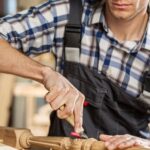What woodworking planes do I need? Woodworking planes are essential tools for any woodworker, helping to smooth, flatten, and shape wood for various projects. Understanding the different types of woodworking planes and how to choose the right ones can be overwhelming for beginners. In this article, we will explore the basics of woodworking planes and their significance in woodworking projects.
Woodworking planes come in various types, each serving a specific purpose in shaping wood. From bench planes to block planes, jack planes to smoothing planes, and jointer planes, each type has its unique function in woodworking. Understanding their roles and knowing when to use them is crucial for achieving precision and quality in woodworking projects.
Selecting the right woodworking planes depends on several factors such as project complexity, wood type, and budget. Beginners often wonder which woodworking planes are essential for their workshop. In this article, we will discuss the must-have woodworking planes for beginners, as well as specialized options for advanced woodworkers.
Additionally, we will delve into maintenance tips and provide step-by-step instructions on using woodworking planes for different tasks. Whether you’re new to woodworking or looking to expand your tool collection, understanding the basics of woodworking planes is crucial for successful projects.
Types of Woodworking Planes
Woodworking planes come in various types, each designed to serve a specific purpose in woodworking projects. Understanding the different types of woodworking planes is essential for woodworkers to effectively achieve their desired results. Below are the main types of woodworking planes:
1. Bench Plane: This type of plane is typically used for removing large amounts of wood and flattening surfaces. It is available in various sizes, with the longer ones being suitable for larger projects while the shorter ones are more versatile for smaller tasks.
2. Block Plane: A block plane is smaller in size and is commonly used for trimming and smoothing small pieces of wood. Its compact design allows for easy maneuverability and precision in shaping edges and end grains.
3. Jack Plane: The jack plane is a versatile tool that can be used for rough work as well as final smoothing. Its medium length makes it suitable for a wide range of tasks, making it an essential plane to have in a woodworking workshop.
4. Smoothing Plane: As the name suggests, this plane is specifically designed for achieving a smooth finish on wood surfaces. It is usually shorter in length with a fine blade, allowing it to create a polished surface without leaving any noticeable marks.
5. Jointer Plane: The jointer plane, also known as the try plane, is used for creating straight and flat edges on boards or panels. It is longer than most other planes and is essential for joining two pieces of wood together seamlessly.
Understanding the different types of woodworking planes will help woodworkers select the right tools for their specific projects based on their needs and budget constraints. When determining what woodworking planes you need, consider factors such as the complexity of your projects, the type of wood you frequently work with, and your overall budget”.
Choosing the Right Woodworking Planes
When it comes to choosing the right woodworking planes for your projects, there are several factors to consider. The type of project you will be working on, the type of wood you will be using, and your budget are all important considerations. Here are some key factors to keep in mind as you select woodworking planes for your workshop:
Factors to Consider When Selecting Woodworking Planes:
1. Project Complexity: Different projects require different types of woodworking planes. For example, if you will be working on small, intricate projects, a block plane may be more suitable. On the other hand, larger projects may require a jointer plane for flattening and smoothing large surfaces.
2. Wood Type: The type of wood you will be working with can also influence your choice of woodworking planes. For softer woods, a smoother plane may be sufficient for achieving a smooth finish. However, harder woods may require a more heavy-duty jack plane to achieve the same result.
3. Budget: Woodworking planes come in a wide range of prices, so it’s important to consider your budget when selecting planes for your workshop. While it’s tempting to invest in high-end, specialized planes, it’s also possible to achieve great results with a basic set of essential planes.
Ultimately, the right woodworking planes for you will depend on the specific needs of your projects and workshop. By considering project complexity, wood type, and budget, you can make informed decisions about which woodworking planes are best suited for your needs.
Essential Woodworking Planes for Beginners
Woodworking is a rewarding and fulfilling hobby, but it can be overwhelming to navigate the world of tools and equipment. Choosing the right woodworking planes is crucial for achieving high-quality results in your projects. For beginners, it’s important to start with a few essential woodworking planes that will cover a range of woodworking tasks. By investing in the right set of planes, beginners can build a strong foundation for their woodworking journey.
Block Plane
One of the most versatile woodworking planes for beginners is the block plane. This compact and handheld plane is perfect for small-scale projects and fine-tuning wood surfaces. Its ability to quickly remove thin layers of wood makes it an essential tool for smoothing rough edges, chamfering corners, and shaping end grain.
Jack Plane
The jack plane is another must-have for beginners due to its versatility and functionality in both rough and finish work. It is typically used for initial flattening and dimensioning of rough-sawn lumber before using finer planes. The jack plane’s longer sole allows it to level uneven surfaces effectively, making it an indispensable tool for preparing wood for further refinement.
Smoothing Plane
When it comes to achieving glass-like smoothness on wood surfaces, a smoothing plane is essential for beginners. This small-sized plane excels at producing fine finishes on boards and eliminating any imperfections left by coarser planes. With its ability to create pristine surfaces, the smoothing plane is ideal for adding the final touches to woodworking projects.
Investing in these essential woodworking planes will provide beginners with a solid toolkit for various woodworking tasks. Knowing what woodworking planes do I need as a beginner can help streamline the process of selecting tools and ultimately enhance the quality of your woodworking projects.
Advanced Woodworking Planes
Woodworking planes are essential tools in any woodworking workshop, and as craftsmen advance in their skills, they may find the need for more specialized planes to tackle specific tasks. Advanced woodworkers often require a different set of woodworking planes to achieve intricate and precise woodwork. In this section, we will explore some specialized woodworking planes that advanced woodworkers may consider adding to their arsenal.
Shoulder Planes
Shoulder planes are designed for creating precise shoulders or rebates in woodworking projects. They are ideal for trimming and fine-tuning joints such as tenons and rabbets. With a distinctive L-shaped blade, shoulder planes allow woodworkers to work up against a square shoulder without damaging the surrounding surface. Their versatility makes them a valuable addition to an advanced woodworker’s toolkit.
Router Planes
Router planes are perfect for fine-tuning the depth of grooves, dadoes, and other recesses in woodworking projects. These specialized planes come with various cutter sizes to accommodate different groove widths, making them incredibly versatile for various tasks such as inlay work and leveling out uneven surfaces. Router planes provide advanced woodworkers with precise control over their cuts, allowing for intricately detailed woodworking.
Molding Planes
For advanced woodworkers interested in adding decorative details to their projects, molding planes are indispensable tools. These specialized planes come in a variety of profiles to create elegant moldings and decorative edges on wooden pieces. From simple chamfers to elaborate coves and ogees, molding planes allow craftsmen to add intricate design elements that elevate their woodworking projects to new levels of artistry.
As craftsmen advance in their skills and take on more complex woodworking projects, the addition of these specialized woodworking planes can enhance the precision and detail of their work.What Woodworking Planes Do I Need.
Maintenance and Care of Woodworking Planes
Woodworking planes are essential tools that every woodworker should have in their workshop. To ensure the longevity and optimal performance of these tools, it is crucial to properly maintain and care for them. Proper maintenance not only extends the life of the woodworking planes but also ensures that they function effectively when in use.
One important aspect of maintaining woodworking planes is keeping them clean and free from debris. After each use, it is advisable to wipe down the planes with a dry cloth to remove any wood shavings, dust, or other particles that may have accumulated during use. Additionally, it is essential to regularly inspect the planes for any signs of wear or damage and address any issues promptly.
Another crucial maintenance tip for woodworking planes is to keep the blades sharp. Dull blades can lead to poor performance and can also damage the wood being worked on. Regular sharpening of the blades using a sharpening stone or system will ensure that the woodworking planes continue to produce clean and precise cuts.
Proper storage of woodworking planes is also essential in ensuring their longevity. When not in use, it is recommended to store the planes in a dry environment away from extreme temperatures and humidity. This helps prevent rust and corrosion on metal parts, while also preventing wooden parts from warping or cracking.
| Maintaining Woodworking Planes | Care Tips |
|---|---|
| Keep them clean | Regularly inspect for wear or damage |
| Keep blades sharp | Proper storage in a dry environment |
Using Woodworking Planes
Woodworking planes are essential tools for any woodworking project, and understanding how to use them properly is crucial for achieving the desired results. Whether you are flattening, smoothing, or jointing wood, using woodworking planes requires technique and precision. Here are step-by-step instructions on how to use woodworking planes for different tasks.
When it comes to flattening wood, a bench plane is commonly used. Start by marking the high spots with a pencil or chalk. Then, position the wood on a flat work surface and hold it firmly in place. Using the bench plane at a slight angle, push it forward along the length of the wood while applying even pressure. Continue working across the grain until the high spots are leveled.
For smoothing wood, a smoothing plane is the ideal tool. After preparing your workpiece by planing with a jack plane, switch to the smoothing plane for finer details. Position the wood on a stable surface and gently push the smoothing plane along the length of the wood using shorter strokes than when flattening.
Jointing wood requires precision and accuracy, which is where a jointer plane comes into play. Start by marking your reference edge and face on each board with an arrow pointing towards each other so that you do not confuse them later. Then use your jointer plane on more problematic boards until they are joined straight.
Having these step-by-step instructions will help you achieve professional-looking results in your woodworking projects regardless of your skill level or experience.
| Woodworking Plane | Task |
|---|---|
| Bench Plane | Flattening Wood |
| Smoothing Plane | Smoothing Wood |
| Jointer Plane | Jointing Wood |
Conclusion
In conclusion, the right woodworking planes are essential tools for any woodworking workshop. Whether you are a beginner or an advanced woodworker, having the appropriate planes can make a significant difference in the quality and efficiency of your projects.
From smoothing and jointing to shaping and finishing, each type of woodworking plane serves a specific purpose, allowing for greater precision and control when working with wood. By investing in quality woodworking planes, you can ensure that your projects are not only easier to complete but also produce professional results.
When considering what woodworking planes you need, it’s important to take into account factors such as project complexity, wood type, and budget. Beginners should start with the essential planes such as a block plane, jack plane, and smoothing plane, while advanced woodworkers may benefit from specialized planes like shoulder planes, router planes, and molding planes.
Additionally, proper maintenance and care of woodworking planes are crucial to their longevity and optimal performance. Regular sharpening of blades and keeping the soles flat will prolong the life of your planes and maintain their effectiveness.
Ultimately, having the right woodworking planes in your workshop will enhance your ability to create beautiful and functional pieces of furniture or other wood items. The precision and control provided by quality woodworking planes will enable you to achieve smooth surfaces and clean edges on your projects. So whether you’re just starting out or looking to expand your collection of woodworking tools, investing in the right woodworking planes is a decision that will benefit you for years to come.
Frequently Asked Questions
What Woodworking Plane Should I Start With?
When starting out in woodworking, it’s recommended to begin with a bench plane. A bench plane is versatile and can be used for various tasks such as smoothing, flattening, and shaping wood. The most commonly recommended type for beginners is the No.
4 or No. 5 bench plane, as they are easy to handle and can perform a range of basic woodworking tasks.
What Planes to Get for Woodworking?
For woodworking, it’s useful to have a few different types of planes in your toolkit. In addition to a bench plane, consider getting a block plane for small-scale work, a jack plane for initial stock removal, and a smoother plane for achieving a finely finished surface.
This combination of planes will cover all the basic functions needed for woodworking projects.
What Size Wood Plane Do I Need?
The size of wood plane you need depends on the specific task at hand. For general woodworking tasks, a mid-sized plane like the No. 4 or No. 5 bench plane is sufficient for most needs.
However, if you’re working with larger pieces of wood or need to cover more surface area, a larger sized plane such as the No. 6 or No. 7 may be more suitable for the job. It’s important to consider the size and scale of your projects when determining what size wood plane to use.

Hi everyone! I’m a woodworker and blogger, and this is my woodworking blog. In my blog, I share tips and tricks for woodworkers of all skill levels, as well as project ideas that you can try yourself.





